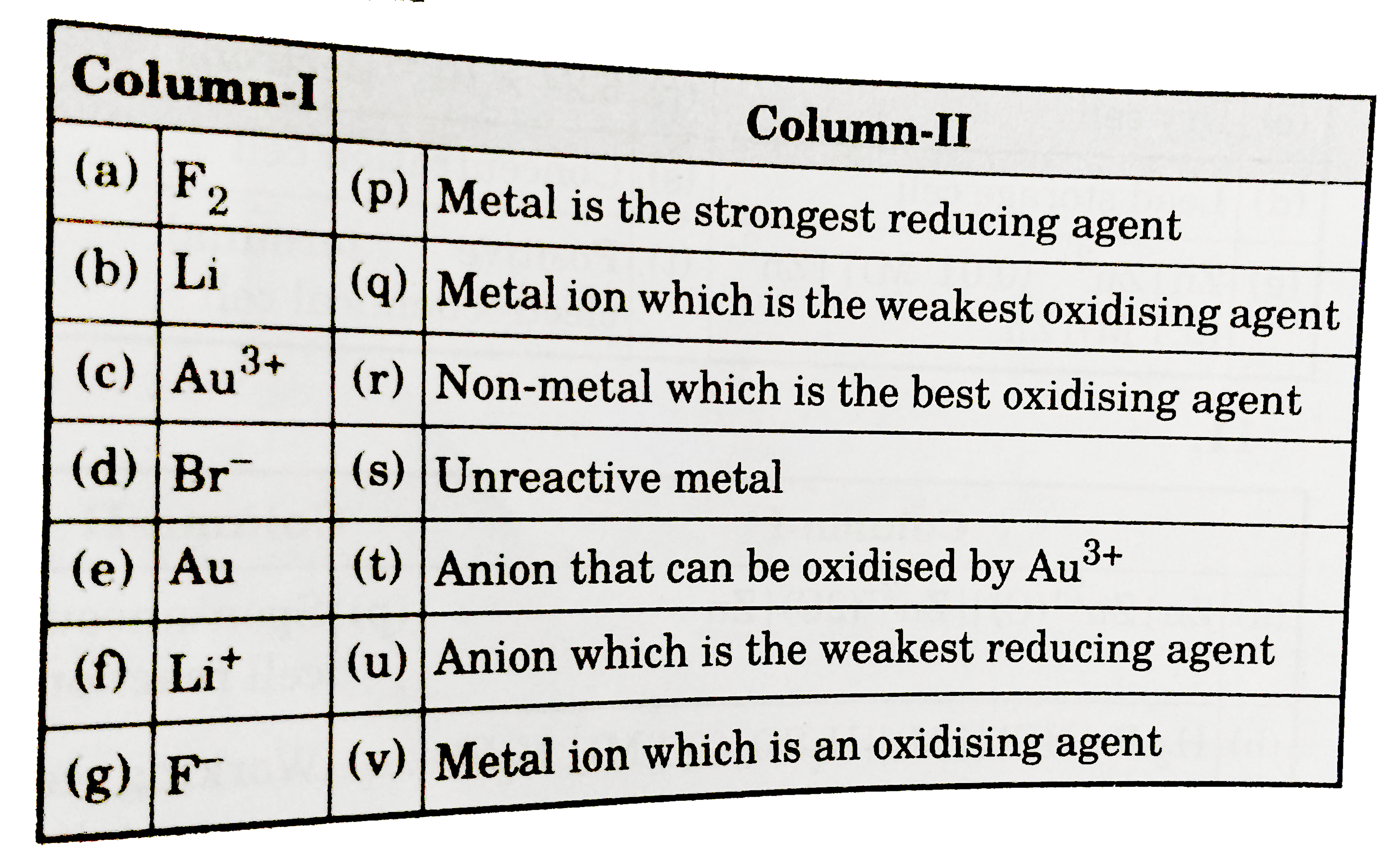Arrange the following metals in increasing order of their reducing power.
E∘K+/K=−2.93V,E∘Ag+/Ag=+0.80V,E∘Al3/Al=−1.66VE∘Au3+/Au=+1.40V,<br>E∘Li+/Li=−3.05V
Li<K<Al<Ag<Au
Au<Ag<Al<K<Li
K<Al<Au<Ag<Li
Al<Ag<Au<Li<K
The correct Answer is:B
Lower the electrode potential, better is the reducing power. The electrode potential increases in the order of Li+/Li(−3.05V),K+/K(−2.93V),Al3+/Al,(−1.66V),Ag+/Ag(+0.80V) and Au3+/Au(+1.40V). Hence, reducing power of metals will be Au<Ag<Al<K<Li.
Topper's Solved these Questions
- BOOK - NCERT FINGERTPS ENGLISHCHAPTER - REDOX REACTIONSEXERCISE - HIGHER ORDER THINKING SKILLS9videos
REDOX REACTIONS
- BOOK - NCERT FINGERTPS ENGLISHCHAPTER - REDOX REACTIONSEXERCISE - NCERT EXEMPLAR PROBLEMS11videos
REDOX REACTIONS
- BOOK - NCERT FINGERTPS ENGLISHCHAPTER - REDOX REACTIONSEXERCISE - MCQs (OXIDATION NUMBER)70videos
REDOX REACTIONS
- BOOK - NCERT FINGERTPS ENGLISHCHAPTER - PRACTICE PAPER 3EXERCISE - Practice Paper 346videos
PRACTICE PAPER 3
- BOOK - NCERT FINGERTPS ENGLISHCHAPTER - SOME BASIC CONCEPTS OF CHEMISTRY EXERCISE - NCERT Exemplar11videos
SOME BASIC CONCEPTS OF CHEMISTRY
Similar Questions
Knowledge Check
- Question 1 - Select One
Given below are the standard electrode potentials of few half-cells. The correct order of these metals in increasing reducing power will be K+/K=-2.93 V , Ag+ /Ag=0.80 V, Mg2+/Mg=-2.37 V, Cr3+/Cr =-0.74 V
AK lt Mg lt Cr lt AgBAg lt Cr lt Mg lt KCMg lt K lt Cr lt AgDCr lt Ag lt Mg lt K
An aqueous solution containing 1M each of Au3+,Cu2+,Ag+,Li+ is being electrolysed by using inert electrodes. The value of standard potentials are :
E∘Ag+/Ag=0.80V,E∘Cu+/Cu=0.34V and E∘Au+3/Au=1.50,E∘Li+/Li=−3.03V
will increasing voltage, the sequence of deposition of metals on the cathode will be :View SolutionFour different solution containing 1M each of Au+3,Cu+2,Ag+,Li+ are being electrolysed by using inert electrodes. In how many samples, metal ions would be deposited at cathode?
[Given :E0Ag+/Ag=0.8,E0Au+3/Au=1.00V
E0Cu+2/Cu=0.34V,E0Li+/Li=−3.03V]View SolutionWhat is ΔG∘ for the following reaction
Cu+2(aq)+2Ag(s)→Cu(s)+2Ag
E∘Cu+2/Cu=0.34VE∘Ag+/Ag=0.8VView SolutionMatch the items of Column I and Column II on the basis of data given below:
(One to one match only)
E∘F2∣F− = 2.87 V, ELi+∣(Li) = -3.5 V,
E∘Au3+∣Au = 1.4 V, E∘Br2∣Br− = 1.09V
 View Solution
View SolutionCan we use a copper vessel to store 1 M AgNO3 solution?
Given
EΘCu2+/Cu=0.34V EΘAg+/Ag=0.80View SolutionDetermine range of E∘ values for this reaction X2+aq+2e−→X(s) for given conditions:
(a). If the metal X dissolve in HNO3 but not in HCl it can displace Ag+ ion but not Cu2+ ion.
(b). If te metal X is HCl acid producing H2(g) but does not displace either Zn2+ or Fe2+
Given E0Ag+/Ag=0.8V E0Fe2+/Fe=−0.44
E0Cu2+/Cu=0.34V E0NO−3/NO=0.96V E0zn2+/Zn=−0.76VView SolutionGiven E∘Cr2O2−7/Cr3+=1.33V,E∘MnO−4/Mn2+=1.51V
Among the following, the strongest reducing agent is E∘Cr3+/Cr=−0.74Vx,E∘MnO−4/Mn2+=1.51V
E∘Cr2O2−7/Cr3+=1.33V,E∘Cl/Cl−=1.36V
Based on the data given above strongest oxidising agent will beView Solution

